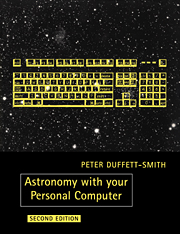Book contents
- Frontmatter
- Contents
- Preface
- Using your personal computer for astronomy
- DEFAULT: default value input routnine & YESNO: ‘Y’ or ‘N’ input routine
- MINSEC: converts between decimal hours/degrees and minutes/seconds form
- JULDAY: calendar date to Julian day number since 1900 January 0.5
- CALDAY: Julian day number since 1900 January 0.5 to calendar date
- TIME: converts between local civil and sidereal times
- EQHOR: converts between equatorial and horizon coordinates
- HRANG: converts between right ascension and hour angle
- OBLIQ: calculates the value of the obliquity of the ecliptic
- NUTAT: finds corrections for nutation in longitude and obliquity
- EQECL: converts between equatorial and ecliptic coordinates
- EQGAL: converts between equatorial and galactic coordinates
- GENCON: converts between any of the coordinate systems
- PRCESS1: approximate precession of equatorial coordinates & PRCESS2: rigorous precession of equatorial coordinates
- PARALLX: converts between geocentric and apparent position
- REFRACT: calculates the effect of atmospheric refraction
- RISET: finds the circumstances of rising and setting
- ANOMALY: solves Kepler's equation for elliptical motion
- SUN: finds the ecliptic coordinates of the Sun
- SUNRS: finds the circumstances of sunrise and sunset
- PELMENT: returns the orbital elements of the major planets
- PLANS: finds the position of a planet
- MOON: finds the position and parallax of the Moon
- MOONRS: finds the circumstances of moonrise and moonset
- MOONNF: finds the times of new and full moon
- ECLIPSE: finds the circumstances of lunar and solar eclipses
- DISPLAY: displays an eclipse in graphical form
- ELOSC: finds positions from osculating elliptical elements
- RELEM: converts elliptic orbital elements from one epoch to another
- PCOMET: finds the position of a comet from parabolic elements
- PFIT: finds parabolic elements from observations & EFIT: finds elliptical elements from observations
- List of variables
- Bibliography
- Index
- PROGRAMS AVAILABLE ON DISK
MINSEC: converts between decimal hours/degrees and minutes/seconds form
Published online by Cambridge University Press: 17 February 2010
- Frontmatter
- Contents
- Preface
- Using your personal computer for astronomy
- DEFAULT: default value input routnine & YESNO: ‘Y’ or ‘N’ input routine
- MINSEC: converts between decimal hours/degrees and minutes/seconds form
- JULDAY: calendar date to Julian day number since 1900 January 0.5
- CALDAY: Julian day number since 1900 January 0.5 to calendar date
- TIME: converts between local civil and sidereal times
- EQHOR: converts between equatorial and horizon coordinates
- HRANG: converts between right ascension and hour angle
- OBLIQ: calculates the value of the obliquity of the ecliptic
- NUTAT: finds corrections for nutation in longitude and obliquity
- EQECL: converts between equatorial and ecliptic coordinates
- EQGAL: converts between equatorial and galactic coordinates
- GENCON: converts between any of the coordinate systems
- PRCESS1: approximate precession of equatorial coordinates & PRCESS2: rigorous precession of equatorial coordinates
- PARALLX: converts between geocentric and apparent position
- REFRACT: calculates the effect of atmospheric refraction
- RISET: finds the circumstances of rising and setting
- ANOMALY: solves Kepler's equation for elliptical motion
- SUN: finds the ecliptic coordinates of the Sun
- SUNRS: finds the circumstances of sunrise and sunset
- PELMENT: returns the orbital elements of the major planets
- PLANS: finds the position of a planet
- MOON: finds the position and parallax of the Moon
- MOONRS: finds the circumstances of moonrise and moonset
- MOONNF: finds the times of new and full moon
- ECLIPSE: finds the circumstances of lunar and solar eclipses
- DISPLAY: displays an eclipse in graphical form
- ELOSC: finds positions from osculating elliptical elements
- RELEM: converts elliptic orbital elements from one epoch to another
- PCOMET: finds the position of a comet from parabolic elements
- PFIT: finds parabolic elements from observations & EFIT: finds elliptical elements from observations
- List of variables
- Bibliography
- Index
- PROGRAMS AVAILABLE ON DISK
Summary
The starting and finishing points of astronomical calculations are usually angles, expressed as degrees, minutes and seconds of arc, or times, measured in hours, minutes, and seconds. Yet computers often cannot handle these quantities as they stand. They must first be converted to decimal degrees or hours before the computation can begin, and then the result converted back into the more-familiar minutes and seconds form. Consider, for example, the problem of finding the time corresponding to 1 hour 37 minutes before 3 : 25 in the afternoon. We first convert the times to their decimal forms, 1.616667 hours and 3.416667 hours, then subtract the former from the latter to get 1.800 hours, and finally convert back to minutes and seconds: 1 : 48 pm.
Your computer can deal with the problem of converting angles or times between decimal and minutes/seconds forms with the aid of the subroutine MINSEC. The direction in which the conversion is carried out is controlled by the switch SW(1). When SW(1) has the value +1, then the quantity represented by the input argument X (decimal degrees/hours) is converted into degrees/hours, minutes, and seconds which are returned by the output arguments XD, XM, XS respectively. XD and XM represent whole numbers while XS represents the seconds correct to two decimal places. The sign of X is returned by the string variable S$ which has the value ‘ + ’ unless X is negative when S$ becomes ‘―’. The real variable SN also carries this information since SN = +1 if X is positive, SN = 0 if X is zero, and SN = −1 if X is negative.
Information
- Type
- Chapter
- Information
- Astronomy with your Personal Computer , pp. 10 - 14Publisher: Cambridge University PressPrint publication year: 1990
